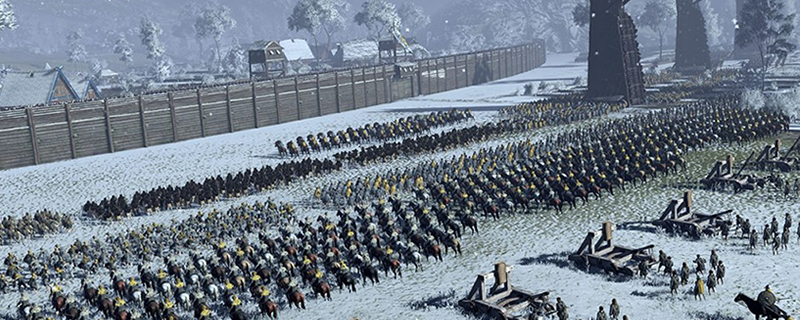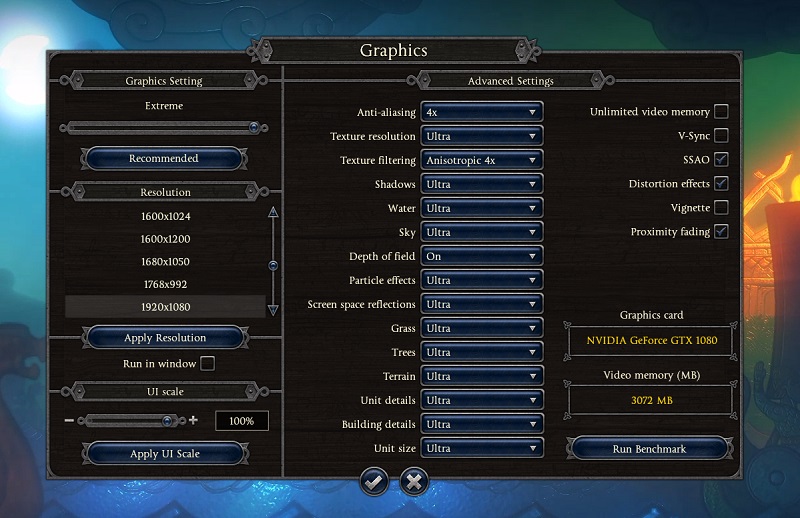Total War Saga: Thrones of Britannia PC Performance Review
Graphical settings – engine regression? Â
As we have mentioned previously, Total War Saga: Thrones of Britannia uses a modified version of the engine used for Total War: Attila, a game which was released back in 2015. The use of this older engine means that many of the new features offered modern games in the series like Total War: Warhammer will be missing, such as “beta” DirectX 12 support, resolution scaling and several other under the hood software changes. Â
With this in mind, it is hard to not see Thrones of Britannia as anything aside from a technological regression, though as you can see below the game still offers a wide range of customisable options to adjust the game’s graphical quality. Below the surface is the fact that Thrones of Britannia is a 32-bit application at its heart, something that is almst unheard of when it comes to modern PC games. Â
Immediately, some of you will notice that Thrones of Britannia is not registering the fact that the GTX 1080 that we used to take this screenshot has more than 3GB of VRAM. This oddity in itself isn’t a huge cause for concern, given how light Thrones of Britannia is on both VRAM and system memory, though it does highlight a bug in the game that shouldn’t be there.Â
Another thing to note is that like other Total War games, Thrones of Britannia uses the same graphical options menu for both real-time battles and the game’s turn-based campaigns. Both of these parts of the game have incredibly different hardware requirements, making it preferable for these two modes to offer players independent graphical options menus. The importance of this will be highlighted later.Â
In Thrones of Britannia, the game’s texture detail setting will be defined by how much VRAM the player’s GPU possesses, automatically adjusting the texture details depending on how much VRAM the player has. For GPUs with 3GB of VRAM or more Ultra is selected, with 2GB GPUs using the game’s high settings.Â
All other settings can be adjusted manually or be pre-defined using one of the game’s five graphical presets, Low, Medium, High, Ultra and Extreme, details for which are available in the table below.
Strangely, Creative Assembly has not used their maximum of 16x Anisotropic filtering for textures on any of their graphical presets, though we would recommend that most players set this option to 8x or 16x, given its minimal to negligible performance impact. Â
Those who are suffering from CPU related slowdown should adjust the game’s Unit Size settings first, as this will have the most direct impact on CPU utilisation in battle. Creative Assembly should take a Ubisoft like approach to their graphical settings in future, where they detail how each setting affects CPU, GPU and memory utilisation, as this will make the optimisation process a lot easier for most PC users.Â
Â
| Â | Low | Medium | High | Ultra | Extreme |
| Anti-Aliasing | Off | Off | Off | MLAA | 4x MSAA |
| Texture Resolution | Automatic | Automatic | Automatic | Automatic | Automatic |
| Texture Filtering | Trilinear | Trilinear | Trilinear | 2x | 4x |
| Shadows | Low | Medium | High | Ultra | Ultra |
| Water | Low | Medium | High | Ultra | Ultra |
| Sky | Low | Medium | High | Ultra | Ultra |
| Depth of Field | Off | Off | Off | Off | On |
| Particle Effects | Low | Medium | High | Ultra | Ultra |
| Screen Space Reflections | Off | Off | High | Ultra | Ultra |
| Grass | Low | Medium | High | Ultra | Ultra |
| Trees | Low | Medium | High | Ultra | Ultra |
| Terrain | Low | Medium | High | Ultra | Ultra |
| Unit Detail | Low | Medium | High | Ultra | Ultra |
| Building Details | Low | Medium | High | Ultra | Ultra |
| Unit Size | Small | Medium | Large | Large | Ultra |
| SSAO | Off | Off | Off | On | On |
| Distortion effects | Off | On | On | On | On |
| Vignette | Off | Off | Off | Off | Off |
| Proximity fading | Off | On | On | On | On |




